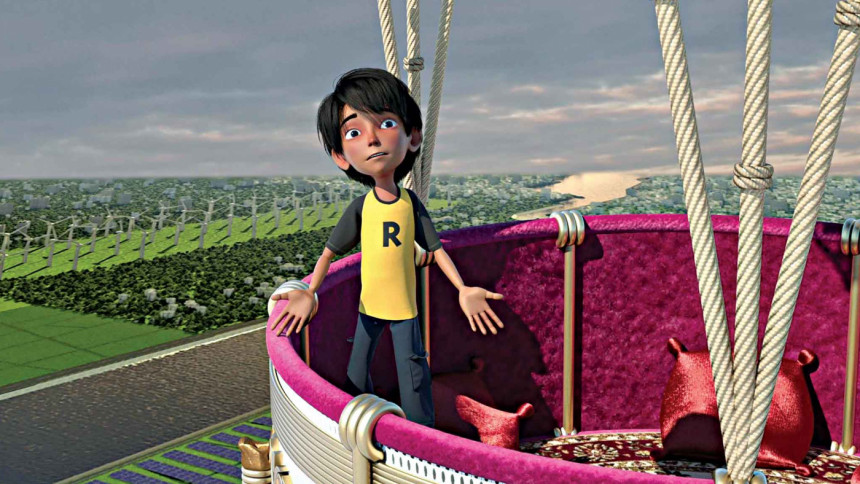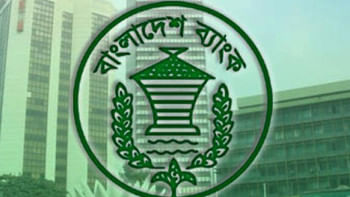Tomorrow, a 3D film by Bangladeshi animators

Ratul Hasan, 6, lives on St. Martin's Island, the southernmost point of Bangladesh. On a nighttime magical journey with "the Old Man of the Winds," Ratul sees two kinds of possible future for his country and the world — one bleak and one bright.
In the bleak future, he sees lands inundated by rising waters, displaced people migrating to the north of the country for refuge, widespread poverty, crowded cities, and illnesses caused by pollution.
The bright future shows a prosperous Bangladesh, where imposition of additional taxes on fossil fuels (natural gas, coal, oil) and subsidies for renewable energy sources (solar panels, windmills) have created new jobs and made the country green and livable once again.
'Tomorrow' is a 26-minute 3D animated film on climate change directed by Mohammad Shihab Uddin and produced by the entrepreneur-climate activist duo Kazi Zahin Hasan and Kazi Zeeshan Hasan of Kazi Farms Group. Tomorrow was released on Deepto TV's YouTube channel on 21 December, 2019, and has been viewed more than 1.2 million times at the time this was written.
The film has recently been dubbed into English to reach the global audience. I watched the English version of Tomorrow after it was released on 17 May. I enjoyed it so much that I later watched the Bengali version, too.
Once you start watching Tomorrow, your mind wonders if it was really made in Bangladesh; Tomorrow has scaled the heights of animation in the country.
In a conversation with Tomorrow's director Shihab Uddin, who also directed 'Shahana,' the animated series produced by UNFPA, and worked as a production manager on four episodes of UNICEF's beloved Meena cartoon. I asked him how challenging it was to make a three-dimensional animated film in the Bangladeshi setting.
"It was challenging every step of the way! Although Tomorrow was initially set to be a two-dimensional film, I took up the challenge to make it a three-dimensional one with the look and feel of a feature film. Thanks to Cycore Studios, the largest animation studio in Bangladesh, and their extremely talented animators," he said.
In a world where people are used to watching high-grade Pixar-Disney animated films, if your 3D film does not 'cut the mustard,' it can be easily rejected by the audience. Keeping this truth in mind, Shihab Uddin and his team at Cycore Studios toiled until they were satisfied with the end results, making every bit of the film as realistic as possible. It took them two years to make the film and another one-and-a-half year earlier to develop the script.
"We paid attention to every little detail, from hair blowing in the wind, clothes of the characters, sea waves crashing onto the shore to trees, branches, mountains, bird's-eye view of Dhaka City, the United Nations room, everything," Shihab Uddin said.
"Tomorrow had a huge number of sets or locations. Each location was different from the other, which meant that it was challenging for us to maintain consistency throughout the film. However, we never thought of giving up, we did not compromise with one single shot," he added.
Produced on a budget of Tk 10 million, Tomorrow was made over a span of two years on one of the most pressing issues of today, climate change. Even though Bangladesh is exceptionally vulnerable to climate crisis, as many environmentalists call it today, there is lack of awareness about it amongst general Bangladeshis.

The film educates through Ratul what we should do today to save our tomorrow. Ratul, upon learning about climate change and global warming during his magical journey, embarks on a climate action movement in Bangladesh that later spreads around the world, distinguishing Bangladesh as a climate champion on the global stage. The film ends with Ratul delivering a speech at the United Nations 25 years later.
The message rendered by Tomorrow is reaching far and wide, garnering praises and admiration. Upon the request of viewers, the film was dubbed into English and released on Deepto TV's YouTube channel on 17 May.
"In the coming days, the film will be released in other major languages, including French, Indonesian, Dutch, Arabic, Spanish, and Urdu," Shihab Uddin said.
Asked how bright he thinks the future for Bangladeshi animators is, Shihab Uddin said, "People from home and abroad are applauding the team and Tomorrow for the work we did and the standard we achieved with limited experience and resources. If we can make 4 or 5 short films like Tomorrow, we never have to look back again. If we can get some support from the government, and if some good producers come forward, then I think Bangladesh can make a mark in the world of animation!"
Before we wrap this piece up, a math problem for our readers to solve: For the film Tomorrow, Cycore Studios needed to render 24 frames per second and it took approximately 30 minutes to create just one frame. How many frames were rendered in total for a film whose duration is 25 minutes 51 seconds?
Photo: Wara Karim


 For all latest news, follow The Daily Star's Google News channel.
For all latest news, follow The Daily Star's Google News channel. 



Comments